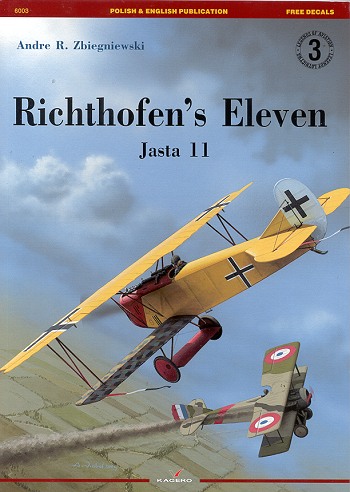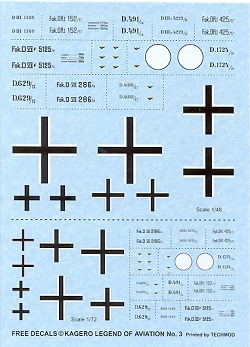 Dealing
mostly with early aviation, this is the third in the series and covers one
of the more famous German Air Service units; Jasta 11.
Dealing
mostly with early aviation, this is the third in the series and covers one
of the more famous German Air Service units; Jasta 11.|
Title: |
Richthofen's Eleven: Jasta 11 |
|
Author: |
Andre R. Zbiegniewski |
|
Publisher |
Kagero |
|
Price |
$21.95 ($19.96 at Squadron) |
|
Reviewer: |
|
| Notes: | Legends of Aviation #3. ISBN 83-89088-54-1 |
 Dealing
mostly with early aviation, this is the third in the series and covers one
of the more famous German Air Service units; Jasta 11.
Dealing
mostly with early aviation, this is the third in the series and covers one
of the more famous German Air Service units; Jasta 11.
This was the unit commanded by Manfred von Richthofen and included such personalities as his brother Lothar, Ernst Udet, Werner Voss and a baby-faced pilot named Hermann Goering.
It is presented in the now standard format for Kagero books. There is an opening story that involves a 'war story' and then proceeds to give the background of the unit and a linear historical perspective. I found the English translation to have been done without the benefit of editing by someone whose primary language is English. Though it isn't a difficult read, the arrangement of sentences is a more literal translation from the Polish. Once you get used to the rhythm of the sentences, it reads just fine.
You'll find that as probably the premier unit, they were given new planes before others. It is Jasta 11 that first flew the famous Fokker triplane. They also had their series of deaths because of the tricky to fly plane and its tendency to shed wings. The Fokker D.VIII was also tried by this unit but found to be sorely lacking (and dangerous to fly). Few if any of these planes were actually used in combat.
Several pages are given to the death of the 'Red Baron', providing a great deal of credence to the fact that he was killed by ground fire and not in air-to-air combat. It seems as if public relations could not stand to have its ace of aces killed by common ground troops so both sides provided stories of death in heroic air combat.
 Besides a
good read, there are a lot of period photographs to go along with the
story. An appendix provides a list of Jasta 11 victories, commanding
officers and bases. For many of us, one of the major highlights of these
books are the excellent profiles, and there are several pages of these
planes; all of them fancifully colored.
Besides a
good read, there are a lot of period photographs to go along with the
story. An appendix provides a list of Jasta 11 victories, commanding
officers and bases. For many of us, one of the major highlights of these
books are the excellent profiles, and there are several pages of these
planes; all of them fancifully colored.
As is expected, there is a decal sheet with this one, covering 10 aircraft in both 1/72 and 1/48 scale. Also given are late war insignia as used on the Fokker D.VIIs. The reason for providing so many aircraft is that the sheet is basically serial numbers. Jasta 11 planes, while very colorful, apparently did not have much in the way of personal markings on their aircraft. There are serials for various Albatros, Pfalz and Fokker aircraft. When looking through the profiles, those with decals to match are clearly marked.
I found this book to be a fascinating read and it is a book that I think you will all enjoy as well.
You can find this book and many others at

If you would like your product reviewed fairly and quickly by a site that has nearly 300,000 visitors a month, please contact me or see other details in the Note to Contributors.